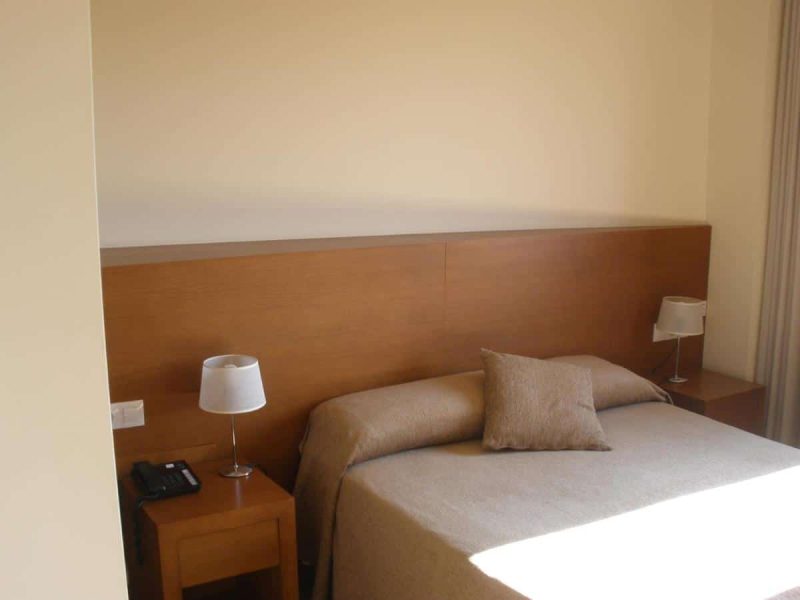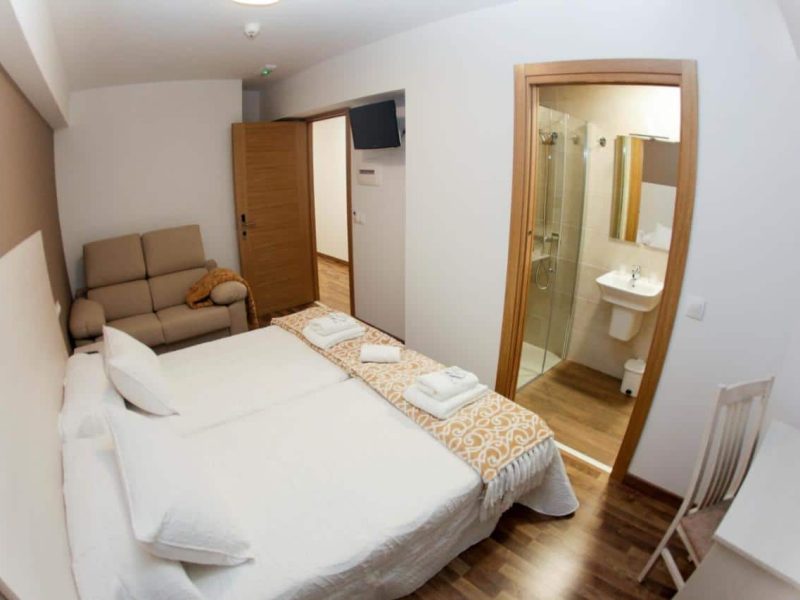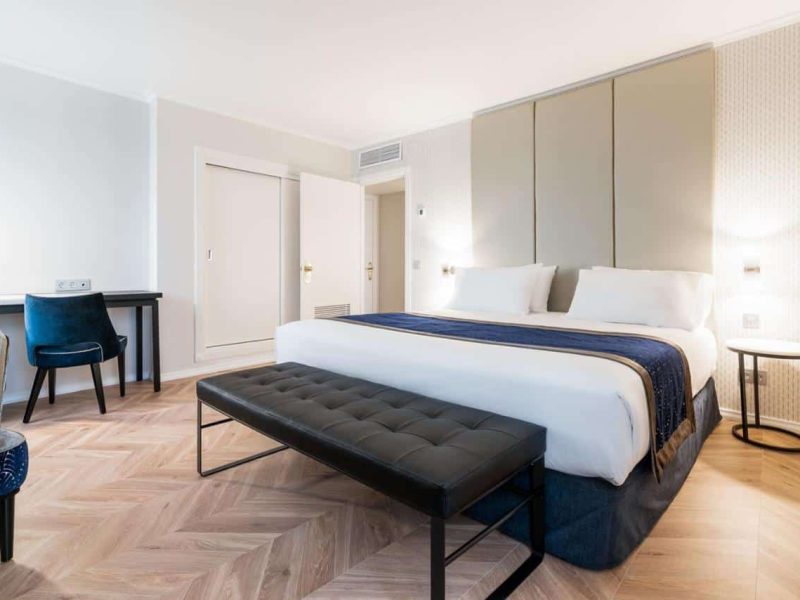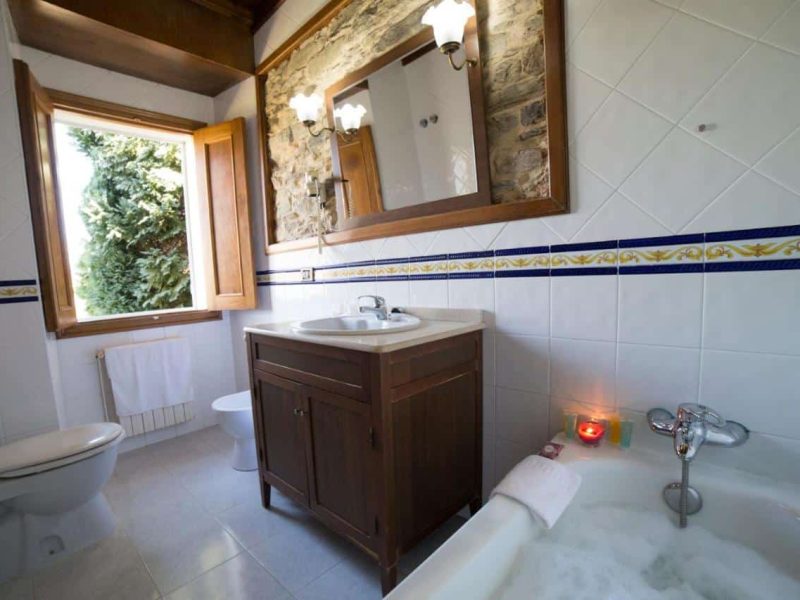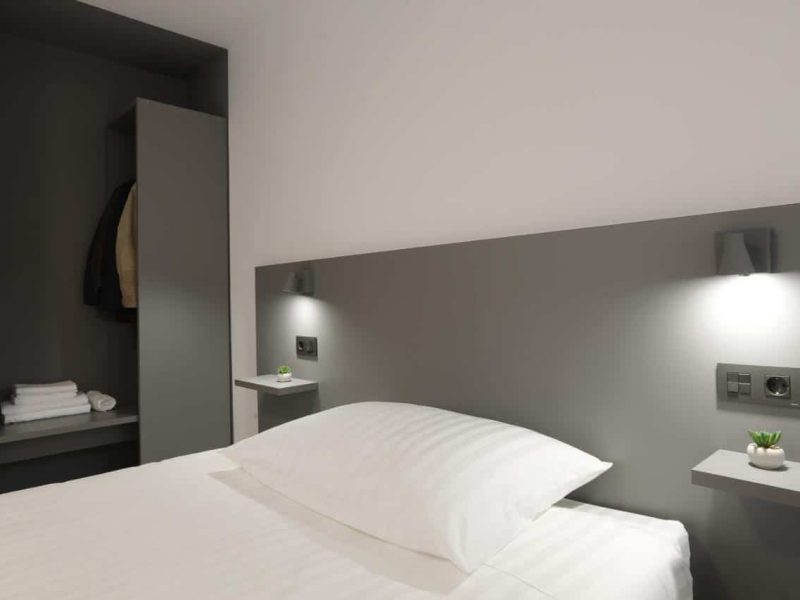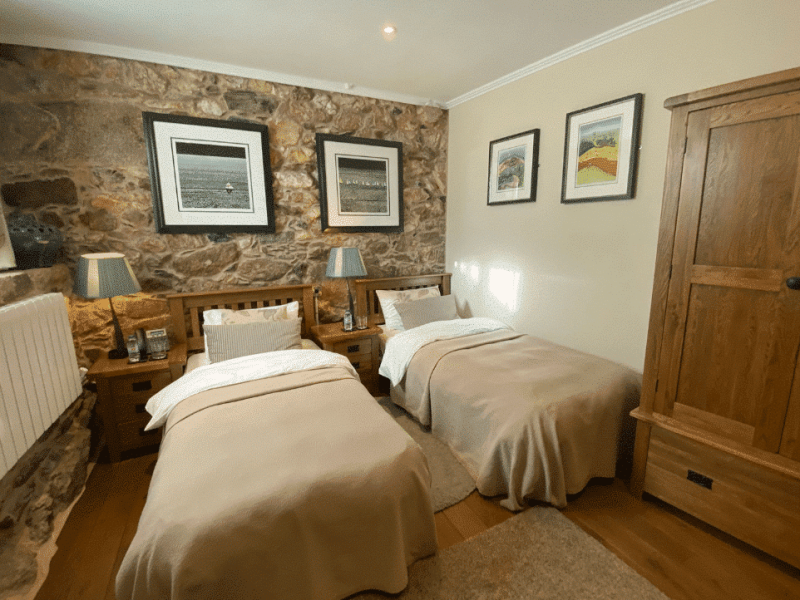Way from Lugo to Santiago...
The first step is the beginning of an unforgettable transformation
The Primitive Way from Lugo organized
A unique journey
Your journey to the European essence.
Way
Immerse yourself in history and tradition
Ready to explore the oldest route of the Camino de Santiago? The section of the Camino Primitivo from Lugo to Santiago de Compostela invites you to explore stunning landscapes, historic cities, and charming villages.
This route is perfect for those who want to combine nature, spirituality, and a connection to the roots of the pilgrimage. Your journey from Lugo to Santiago will not only be a physical journey, but a life-changing experience.
Dare to walk the trails that follow the footsteps of King Alfonso II, who made this journey in the 9th century to visit the tomb of the Apostle.

Your adventure begins here
Want to experience something authentic? This journey along the Camino Primitivo from Lugo is designed to offer you the best of Galicia: a combination of rural landscapes, Galician hospitality, and historical heritage. You will discover an authentic region, enjoying its gastronomy and unforgettable moments as you walk towards Santiago de Compostela.
With our help, you’ll have everything you need to focus solely on enjoying the journey. From accommodation to luggage transport, we take care of all the details so that your only concern is advancing towards your final destination.

More details
Origin
Lugo

Destination
Santiago

Duration
7 days / 6 nights / 5 stages

Total Kms
103

Price / person
€595 (double room)
Book now!
Indicates the number of people

servicios
Services
Complete and customizable services to make your experience on the Camino Primitivo unforgettable.
Services Included
- Accommodation in carefully selected hotels, rural houses and hostels.
- Special breakfast to start each day with energy.
- Travel assistance insurance valid throughout Spain.
- Assistance vehicle in case of emergency during the Camino.
- Informative digital dossier on the Camino.
- Telephone assistance during the route to resolve any questions.
- Luggage transfer at each stage (1 suitcase per person up to 20 kg).
- Special gifts, such as the Pilgrim's Credential and typical Galician products.
- No cancellation fees up to 10 days before starting the Camino.
- VAT included in the price.
Optional Services
- Division of long stages into additional days.
- Extra night in Santiago de Compostela.
- Cancellation insurance for residents in Spain and abroad.
- Day trips to Finisterre (Costa da Morte) and Rías Baixas.
- Transportation of additional luggage, if you need more than one suitcase per person.
- Option to carry additional luggage if you need more than 1 suitcase per person.
Remember that optional services will be added to the base cost of the route
Stages of the Primitive Way from Lugo
Your trip is divided into 5 stages (plus arrival and departure): A journey of approximately 105 kilometers from the walled city of Lugo to the Cathedral of Santiago de Compostela.
Day 1: Arrival in Lugo. Lodging.
Welcome to the beginning of your journey. Get ready for an unforgettable adventure!
Day 2: Stage from Lugo to San Roman de Retorta (19.6 kms)
- Duration: 4h 45m
- Difficulty: Low
Breakfast and start of the first stage of the Way of Saint James from Lugo.
In Lugo, its historic center and walls will not leave you indifferent. The walls of Lugo are the only ones in the world that preserve their complete layout.
A short stage with no difficulty that runs through flat terrain or on a slight descent on asphalt or shoulders for pilgrims. Seoane and San Vicente de Burgo are the villages of the Way that we will pass through.
Arrival in San Roman de Retorta. End of the stage.
Day 3: Stage from San Roman de Retorta to Melide (29.48 kms)
- Duration: 7h 30m
- Difficulty: Medium
Breakfast and start of the stage.
A long stage that runs partly along the Way or an ancient Roman way, at the beginning of it.
Numerous crossings, tracks, and villages will be covered in this stage, with some significant ups and downs, nothing compared to the previous stage, which is totally flat.
Finally, we arrive in the town of Melide, where it joins the French Way. End of the stage.
Day 4: Stage from Melide to Arzua (14.5 kms)
- Duration: 3h 30m
- Difficulty: Medium
Breakfast and start of the stage.
For lovers of good food, Melide, famous for its octopus, is a mandatory stop for the pilgrim, as well as remembering that Arzúa gives rise to the denomination of origin of its famous tetilla cheeses.
Most interesting places we will find: Church of Santa María de Melide – Museum of Melide – Bridge of Ribadiso do Baixo – Church of Santiago (Arzúa)
Arrival in Arzúa. End of the stage.
Day 5: Stage from Arzua to Pedrouzo (19.2 kms)
- Duration: 4h 40m
- Difficulty: Low
Breakfast and start of the stage.
An easy walking stage with pleasant orography for the pilgrim through wooded areas, with small sections close to the road until concluding in the town of Pedrouzo.
Arrival in Pedrouzo. End of the stage.
Day 6: Stage from Pedrouzo to Santiago de Compostela (19.9 Kms)
- Duration: 5h
- Difficulty: Low
Breakfast and start of the stage.
Like the previous stage, it is a gentle stretch, except for the climb to San Marcos, starting in Lavacolla. We pass by Monte do Gozo and descend on our Way of Saint James from Lugo to the long-awaited goal in Santiago de Compostela.
Arrival in Santiago de Compostela. Lodging.
As the organizing agency of the Camino de Santiago, we can only offer our congratulations on reaching the end of the Way! Do not forget to request your Compostela and the Distance Certificate. We tell you that all of Santiago de Compostela deserves a leisurely and relaxed visit; as well as its surroundings.
Day 7: Breakfast–End of our services
We’re coming to the last day of your trip! Enjoy breakfast and conclude this unforgettable experience with us.
Thank you for being part of this adventure!
This itinerary will take you through the most popular stages of the Camino Frances and allow you to experience the beauty of Galicia and the culture of the Camino de Santiago. Make sure you book accommodation in advance as it can get busy, especially in peak season. Have a good trip and good Camino!
Accommodation
We are committed to ensuring your rest and comfort at every stage of the Camino.
The accommodations we carefully select include private rooms with bathrooms, designed to provide you with a quiet and comfortable place to recharge after the day’s walk. Additionally, all the establishments offer the necessary services to meet the needs of the pilgrim, from a cozy bed to a relaxed atmosphere.
Spaces are often limited, especially during peak season. Therefore, we will confirm the exact name of each accommodation once your reservation is made and availability is verified for the selected dates. We want you to enjoy your journey without worries.

Frequently Asked Questions
What to See and Do on the Way from Lugo to Santiago (Travel Guide)
STAGES FROM LUGO TO SAN ROMAN DE RETORTA AND MELIDE
We start with the incredible historic center of Lugo and its walls that will not leave you indifferent.
In San Román de Retorta, its small 12th-century Romanesque-style Church stands out.
In Melide, as the stage-ending town, we recommend the following places to visit:
> First, we cannot miss tasting its famous octopus, in any of its renowned pulperías. Similarly, you have a magnificent ethnographic museum, Terra de Melide, recently built and unique in the area. The gastronomy on the French Way is one of the most renowned not only on the Way of Saint James but also at the national level in Spain as a whole.
> We also highlight the Melide Cross, which they say dates from the 19th century and may be the oldest in the entire Galician region. Next to this magnificent cruceiro, we find the Chapel of San Roque (a jewel of Romanesque architecture) that many have found to resemble the current 10€ note. The ticket simply reflects an example of Romanesque architecture in the strictest sense and is not associated with any specific monument (thus avoiding issues). At least we can say that the arches and columns of the door of this chapel in Melide reflect the purity and perfection of the Romanesque style.
> Also notable is the Church of the Sancti Spiritus and the Romanesque temple of Santa María.
> In the vicinity of Melide, we can also visit the pre-Romanesque Church of San Antoniño de Toques, located in a spectacular setting amidst a waterfall that runs alongside the church. The pre-Romanesque style church consists of a nave. Above the triumphal arch, there is a Romanesque carving of a Calvary from the 13th century.
Outside the route of what to see on the Primitive Way from Lugo but well worth a detour if we have time for it, in Sobrado dos Monxes, near Melide, is located The Monastery of Santa María de Sobrado dos Monxes, one of the main medieval origin monasteries of the province of A Coruña and all of Galicia. It is believed to date from the 10th century, as several writings have been found citing it. It has undergone numerous renovations from the 16th to the 18th century.
Today, the Church of the Monastery of Sobrado dos Monxes is well preserved, as well as part of its monastic dependencies, thanks to the work of the Benedictine monks who inhabit it. The Church dates from the 17th century and is Baroque in style. The spectacular facade with two slender towers stands out. Its entire interior is worthy of admiration. The Monastery preserves three cloisters. It was declared a National Historic-Artistic Monument.
Upon arriving in Melide, we meet the pilgrims who are taking the route from Sarria to Santiago, part of the French Way variant, to head together towards Santiago on a single path. From Monte do Gozo, at the gates of Santiago, we will enjoy an exceptional view of the Cathedral and the city of the Apostle.
STAGE FROM MELIDE TO ARZUA
In Boente, the Church of Santiago stands out, presided over by a 19th-century carving of the Apostle.
In Ribadixo do Baixo, after crossing the bridge of medieval origin, is the Ribadixo pilgrim’s hospital, the last historical space that remained open to serve the pilgrim. In the recreational area of Ribadixo, we can take a break to refresh our feet in the river.
In Arzúa, the Church of Santiago stands out, with the Gothic Chapel of Magdalena, belonging to a vanished hospital. Next to a grove of oak trees, the chapel of A Mota also stands out.
About 5 kilometers off the route of what to see on the Primitive Way from Lugo, the Pazo de Brandeso stands out, where Valle-Inclan set part of his novel “Sonata de otoño.” The Pazo is privately owned and cannot be visited. It is a stately building with a chapel on its main facade.
STAGE FROM ARZUA TO PEDROUZO
Firstly, we highlight the Parish Church of San Verisimo, in the town of Ferreiros.
In Santa Irene, we can visit the Chapel of the Saint, which gives its name to the town. A hermitage dedicated to this Portuguese martyr saint. Also notable is a baroque fountain said to have skin-healing properties.
We cannot miss the opportunity to taste the magnificent Arzúa-Ulloa cheese. Since 1989, this artisanally made cheese, from natural and whole cow’s milk, has been designated as a Galician Quality Product. It is produced in all the municipalities of the Arzúa-Ulloa region: Arzúa, Curtis, Melide, O Pino, Santiso, Sobrado dos Monxes, Toques, Touro, and Vilasantar (in the province of A Coruña) and Friol, Monterroso, and Palas de Rei (in the province of Lugo).
STAGE FROM PEDROUZO TO SANTIAGO DE COMPOSTELA
Before reaching Santiago, about 4 km away, Monte do Gozo offers an incredible panoramic view of the city.
We conclude our post on what to see on the Primitive Way from Lugo to Santiago de Compostela with the culmination in the city of Santiago de Compostela, where we find the most important monument of our entire route, the Cathedral of Santiago, dedicated to the Apostle James.
It was consecrated in 1128 and is a good example of a pilgrimage church.
Of Romanesque style, with later Renaissance and Baroque elements from the 18th century. With a Romanesque Latin cross plan, it has three naves divided by semicircular arches, a tribune, transept and ambulatory.
The Pórtico de la Gloria, by the master Mateo, is the best example of Spanish Romanesque architecture.
As a tradition and final touch in our what to see and do on the Primitive Way from Lugo, any pilgrim who wishes and is able can attend the mass at 12 and 7:30 pm in the Cathedral. Here, with a bit of luck, you will be able to see the magnificent botafumeiro in action. *In 2019, due to works inside the Cathedral, this mass will be held in other nearby churches. The Cathedral prepares its best finery for the upcoming Holy Year 2021.
The whole of the old town is spectacular, taking you back to medieval times without even realising it. There you will find the Mercado de Abastos de Santiago. On the other hand, you can also get to know the surroundings of Santiago and go on organised excursions along the Costa da Morte and Rias Baixas.
Another tradition is to embrace the image of the Apostle James and visit his tomb.
A visit to its museum is a must, as well as a visit to the roofs of the Cathedral.
The Monastery of San Martín Pinario, opposite the Plaza de la Azabachería.
The façade of the Parador de los Reyes Católicos, in the Plaza del Obradoiro, which was founded as a pilgrims’ hospital.
The whole of the old town is spectacular, taking you back to medieval times without even realising it. There, you will find the Mercado de Abastos de Santiago, the Galicia Pavilion in the San Lázaro neighborhood, the Pantheon of Illustrious Galicians (next to the museum), the Chapel of As Animas, Praza de Cervantes, the Museum of the Casa de la Troya, etc.
The whole of the old town is spectacular, taking you back to medieval times without even realising it. It is home to the Abastos de Santiago market. On the other hand, you can also get to know the surroundings of Santiago and go on organised excursions along the Costa da Morte and Rias Baixas.
Now, what we recommend in our what to see on the Primitive Way from Lugo is that you discover these incredible places for yourself and tell us what you thought.
How to Get to Lugo
We indicate the different options on how to get to the French Way starting in Lugo. A town that marks the minimum distance, if you do the Way on foot, of 100 Kms to obtain the “La Compostela” certificate
Option 1: Personal car and leave the vehicle parked in Lugo. You can park in the vicinity of the accommodation where you are staying. It is a very safe and small town where, to date, there have been no security problems. Another option is to request private parking.
Option 2: Bus
> Journey from Santiago to Lugo
– From Santiago de Compostela city or from its Airport, to Lugo you can travel with the Freire bus company.
> Journey from Madrid to Lugo
– From Madrid to Lugo with the Alsa company, with frequent departures from the Madrid South Bus Station, and from the Madrid Airport (Terminal 4)
Option 3: Airplane
The nearest airport to Lugo is Santiago de Compostela, approximately 1h 15′ by car.
From here there are two possibilities to get to Lugo:
– By bus, option seen previously.
– Private transfer with us: pick-up at Santiago Airport and direct transfer to Sarria in approximately 1h 15′. Please ask us for the price of the service.
What makes the Lugo-Santiago section on the Primitive Way special?
The Primitivo Way from Lugo stands out as the final stretch of the oldest route to Santiago. Unlike other more crowded routes, such as the French Way, this section offers a perfect balance of peace, history, and nature.
The landscapes are varied, with lush forests, green meadows, and traditional villages that preserve the rural essence of Galicia. Furthermore, upon reaching Melide, the Primitivo Way joins the French Way, allowing you to experience the company of more pilgrims in the final stages towards Santiago.
What is the best time to travel this section?
The best time to do this stretch is between April and October, when the weather is most favorable. During these months, temperatures are pleasant, though you should be prepared for occasional rain, especially in spring and autumn.
July and August are the busiest months, ideal if you’re looking for a more social experience. If you prefer peace and quiet, the best options are April, May, September, and October, when there are fewer pilgrims and the landscapes are at their peak beauty.
What is the difficulty level of the Lugo-Santiago section?
This stretch has a low to medium difficulty, making it accessible for pilgrims with average physical condition. Most of the stages are gentle, with moderate slopes. Some ascents and descents, such as those around Melide, may require a bit more effort.
If any stage proves too challenging, you can choose to split it into additional days to make the journey more manageable and enjoy the path at a relaxed pace.
What cultural and natural attractions stand out in this section?
In addition to the points already mentioned, here are other attractions worth exploring:
- Church of San Romao da Retorta: a beautiful example of Galician Romanesque architecture located in a quiet village. Its simple yet symbolic structure makes it a perfect place for a brief pause and reflection.
- Pazos de Ulloa: on your way to Melide, you’ll pass through this rural area that evokes the stories in the novel by Emilia Pardo Bazán. It’s a region famous for its rolling landscapes, vineyards, and traditional buildings such as pazos, offering a glimpse into Galician history.
- Cruceiros and Wayside Fountains: in this stretch, especially near Arzúa, you’ll find numerous cruceiros (stone crosses) that symbolize the spirituality of the way. Also, historical fountains like the one in Santa Irene will allow you to refresh and connect with the pilgrim tradition.
- Medieval Bridge of Furelos: In the town of Furelos, near Melide, you’ll find this medieval bridge crossing a picturesque river. It is one of the most beautiful bridges along the Primitivo Way.
- Church of Santa María de Leboreiro: this small Romanesque church, located just before reaching Melide, stands out for its simplicity and charm. The surrounding village is a typical Galician hamlet with granaries and stone houses, offering an authentic postcard of rural Galicia.
- Ribadiso do Baixo: this spot, located just before Arzúa, is one of the most picturesque corners of the way. Here, a medieval bridge crosses the Iso River, and it is an ideal place to rest and enjoy the sound of the water and nature.
- Eucalyptus and Oak Forests: between Arzúa and Pedrouzo, the paths are surrounded by dense forests that offer shade and a cool atmosphere for walking. These landscapes reflect the natural diversity of Galicia, with small streams and local wildlife accompanying the pilgrim.
Lavacolla: just before reaching Santiago, this place has a special meaning in the way tradition. Pilgrims used to stop here to purify and wash themselves before entering the holy city. Today, the river that crosses the area remains a symbolic location.
Is it possible to modify the duration of the Way from Lugo to Santiago?
Of course! We adapt to your needs and preferences to ensure that your Camino experience is unique and comfortable. Although the standard itinerary is designed to be completed in 6 days of walking, you can choose to split the longer stages into shorter days by adding extra days to your journey.
This is especially recommended if you prefer to walk at a more relaxed pace, enjoy the landscapes and points of interest more, or if you are traveling with children or elderly people. You can also add an extra night at the start in Lugo to explore the city, or at the end in Santiago to leisurely enjoy its impressive historic center and cathedral.
Can I stamp the pilgrim's credential?
Along the Way, you will find numerous places to stamp your credential, such as churches, hostels, bars, and restaurants. Some highlights on this stretch are:
- The Cathedral of Lugo and other temples in the city.
- The Church of Santa Eulalia de Bóveda.
- Stops in Melide, such as the municipal hostel or local bars.
- The Pilgrim’s Office in Santiago for the final stamp and to receive the Compostela.
It is recommended to stamp your credential at least twice a day during the last 100 kilometers, which is the minimum requirement to obtain the Compostela.
Do you still have doubts about the Camino?
This video will give you a more detailed and visual look at what to expect on your adventure. Don’t miss it!









